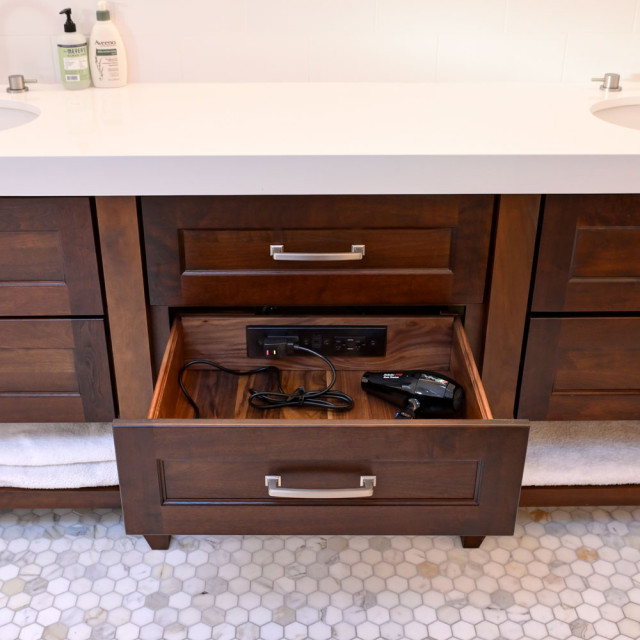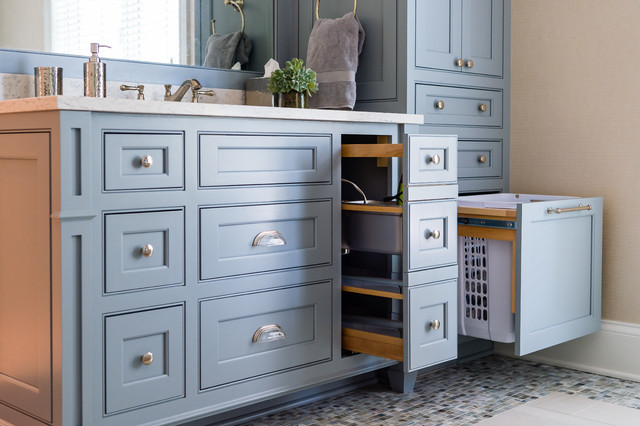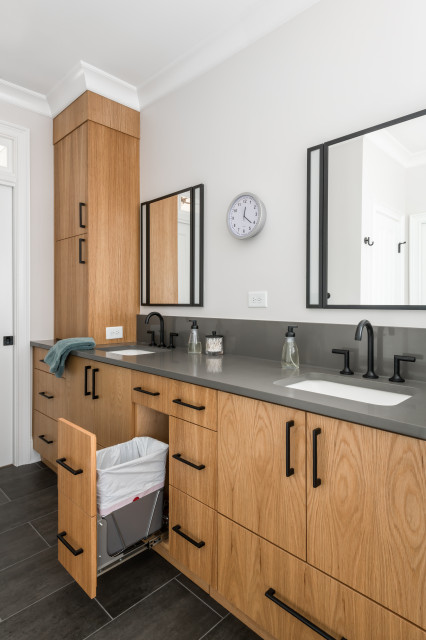

A standard interlocking thermostat cuts power to the outlet if the surrounding temperature exceeds 120 degrees Fahrenheit (49 degrees Celsius).


It’s common knowledge that a vanity drawer directly below and in front of a bathroom sink is often not what it seems. That’s because sink plumbing in the cabinet means a full-size drawer isn’t possible — it would bump against the plumbing parts. Designers get around this by making a shallow drawer or a U-shaped design that goes around the plumbing.
But many pros recommend skipping all that for a full-size drawer below a cabinet, as shown on this stylish vanity in an Orange County, California, bathroom by designer Madison Bettis of Madison Taylor. “They function well for storage, and it’s usable space instead of a faux drawer at the top that you can’t use because of the sink,” Bettis says.
Architectural designer Danielle DiVittorio of DiVittorio Architecture & Design agrees. “Bathroom vanities lose storage space because of the sink, but working around this is always a plus for clients,” she says.

An open shelf instead of drawers is also a popular option.

When it comes to storage, one size doesn’t fit all. Pros recommend mixing up the depth and width of your drawers, and in some cases cabinets, to accommodate small items like makeup as well as larger items like bottles of lotion and electronics. “Having just two or three large drawers often results in more clutter, making it hard to find items you’re looking for,” says designer Cynthia Stafford of TruDesign. “Smaller drawers make us place items with more thought and intention, and with a shallow depth we can’t cram too much in one space.”
Here, a Rev-A-Shelf drawer features a shallow section with trays to hold makeup and other accessories, while a deeper area below stores a hair dryer.


In addition to drawers, home pros are all about pullout storage. Similar to drawers, these are often paneled sections on rolling tracks that hold larger storage components, such as the aforementioned organizers for hair dryers and electronics. Pros also recommend using these pullouts to add things like hidden laundry hampers and trash bins.
This vanity in a Cleveland bathroom by House of L features a pullout for electronics as well as a laundry hamper.


A workstation is often only as good as its available work surface. So maximizing countertop space goes a long way toward assisting with everyday bathroom tasks. “Counter space is the key bathroom vanity feature that we always recommend to our clients,” designer Victoria Chen of Studio Define says. “Because we all could use more counter space for our ever-increasing collection of bathroom accessories and decorations.”
This Los Gatos, California, bathroom by Symmetry Designs features a substantial double vanity with generous counter space that offers opportunity for stylish decor.


“Pay close attention to useful counter space as well as functioning storage below,” custom cabinetmaker Charlie Henderson of Woodshop QC says. “I accept that, visually, people lean toward a centered sink. But especially on 36-to-42-inch-wide vanities, I prefer to shift the sink off center to allow for a normal-functioning drawer stack on the end, where the drawers can avoid the sink plumbing and don’t have to be notched and butchered on the inside.”
Vanity: Danny in Maple Gray with Carrara marble top, 36 inches, Ari Kitchen & Bath

Pros are pretty evenly divided on countertop recommendations for bathroom vanities: quartz versus natural stone.
For quartz, the durability is the benefit. “They are impervious to most things you use in a bathroom,” designer Marie Frenkel of DreamStyle Kitchens & Baths says. Price and range of styles are also notable selling points.
A quartz countertop on a wood vanity joins polished nickel finishes and creamy backsplash tile in a herringbone pattern to create an elegant look in this Philadelphia bathroom by Spring Creek Design.


For some pros and homeowners, nothing compares with the look and feel of real stone. “They always feel warmer and more welcoming than artificial or man-made products,” general contractor Matthew Harper of Harper & Co. says.
Plus, some say the cost and durability for some stones aren’t all that different from quartz. “We love using natural marble for areas that are close to touch, such as countertops,” designer Adina Hall says. “Carefully selected marbles such as Olympian Danby and a few others can be quite resilient as they are not very porous and priced similarly to a quartz. For countertops we triple-seal them.”
In this Bozeman, Montana, bathroom by Brechbuhler Architects, a slab of gray quartzite adds gorgeous swirls that complement the grains in the wood accent wall.


Whether you’re going with a prefabricated unit or a custom cabinet, many pros agree that cabinet hardware plays a big role in a vanity’s look and feel. “You can find some really beautiful off-the-shelf vanities these days,” designer Kirsten Krason of House of Jade Interiors says. “Make sure you are looking for something with classic and elevated hardware. The hardware comes included with these premade pieces, so it’s important that it matches the style of your home.”
You can also often swap out the knobs and pulls for something that offers more impact. “It’s a budget-friendly way to make an off-the-shelf vanity look custom,” designer Kristyn Harvey says.



Many pros often recommend a floating vanity, regardless of the size of the bathroom. These wall-hung units keep the flooring continuously visible, giving the appearance of more space and the often-stocky pieces a lighter look.
A large floating double vanity creates an airy feel in this Boston bathroom by Lawless Design.



As mentioned earlier, maximizing storage is often the name of the game when it comes to bathroom vanities. And sometimes that means going above and beyond, literally. Some home pros recommend adding storage towers to a vanity to put often-used items right at eye level. As with other storage components mentioned in this article, you can customize towers to include integrated electrical outlets, shallow and deep storage and pullouts with organizers.
A countertop storage tower makes the most of a corner on this vanity in a Houston bathroom by Cindy Aplanalp & Chairma Design Group. Also notice the slim drawer for storing smaller items.



By far the feature pros most recommend for bathroom vanities is in-drawer outlets. Some prefabricated vanities come with an interior outlet, but this option is typically more common with custom-designed vanities.
Pros clearly feel the effort is worth it. An outlet allows you to keep electric toothbrushes, shavers, hair dryers and other devices plugged in and off the countertop, which reduces clutter. “And when you’re blow-drying your hair the cord is not knocking over things you have on the countertop,” designer Amanda D’Ascanio of AKD Interiors says.
A vanity pullout in this Oklahoma City bathroom by Edmond Kitchen & Bath features an integrated outlet for electronics.